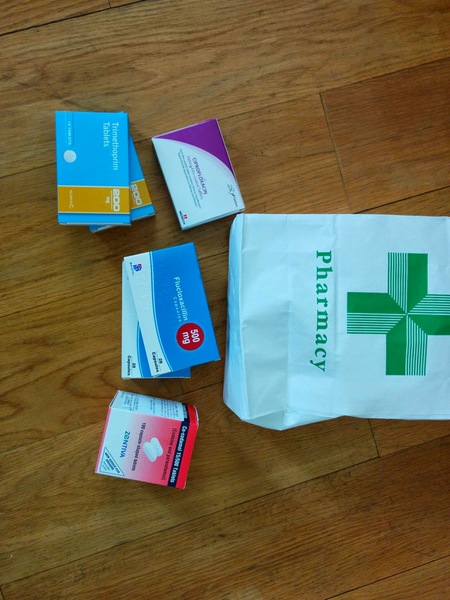In New Zealand we're going to be up a mountain, six hours walk from our cars and then two hour drive from Nelson, the closest city with any medical facilities. Although New Zealand has an excellent Mountain Rescue service, it would be nice to be able to deal with as many problems as we can by ourselves, without needing to call out an expensive helicopter and paramedics.
What we're taking
Tanguy, Rhys and I all took the Expedition First Aid course, and one of the instructors was Dr Simon Green, who wrote us a private prescription for several useful medications. There's always a temptation to take as much as possible, but the cost becomes significant, so we've tried to be minimalist:-
- Co-codamol: A mixture of paracetamol and Codeine, an opiate analgesic (pain killer). Good for pain that cannot be managed using ibuprofen or paracetamol
- Diclofenac: A non-steroidal anti-inflammatory (like ibuprofen) analgesic. We have a prescription for five ampoules of this, which need to be injected intramuscularly, probably into the thigh or deltoid (shoulder muscle). This is a very strong pain killer, and we would only use it in a dire situation where the casualty was far from help and needed pain management. We wanted to have tramadol, but this was reclassified by the UK government just prior to our trip and can no longer be prescribed
- Lidocaine: A local anaesthetic that we have in ampoules. It is intended for injections around the site of a soft tissue injury that must be sutured (stitching a cut) to provide pain relief during the suturing
- Ciprofloaxin: A broad spectrum anti-biotic, which we intend to use to treat severe diarrhoea. It's something of a nuclear option, so we won't use it as soon as symptoms present
- Flucloxacilin: A narrow-spectrum, penicillin based anti-biotic, intended for treated infected soft tissue injuries, ie. deep cuts. This will be very useful as caving usually leaves us with a few cuts, and on top of a mountain these can become quickly infected
- Trimethoprim: An antibiotic for treating urinary tract infections. Covers are notoriously smelly, and a few weeks on a mountainside with stale underpants could cause problems. Lovely
- Prochlorperazine: An anti-emetic (stops you throwing up) that is injected intramuscularly, much like Diclofenac. The purpose here is to prevent vomiting for long enough for the patient to take other medication
Bartering for Drugs
Because we have a private, rather than NHS prescription, the cost of each drug is not fixed at the standard £8.05. This means individual pharmacists can set their own prices, and the prices can vary dramatically. We first went to Boots (for non-UK readers, this is a large, well known chain) where they quoted £62, a bit more than we wanted to pay. We checked out three independent pharmacies, and were quoted £90, £100 and £110. The fourth pharmacy kept us waiting for twenty minutes, and then told us that the pharmacist was busy, and we should leave - we obviously weren't the clientele they wanted!
I then went to Sainsbury's (again, non-UK readers, a large supermarket chain that has an in house pharmacy in its larger stores) who quoted £24 for the pills but said they couldn't find lidocaine on their system. Fortunately our prescriptions were on two pieces of paper, so I got the pills from Sainsbury's (who promptly charged me £28 - my attempts to argue were fruitless) and the ampoules from Boots. The bottom line here is that it's definitely worth shopping around - some places wanted to charge two to three times as much for the same drugs!
We already have needles and syringes courtesy of Dr Green, so we're all set for medication. I've ordered two travel size sharps bins (apparently diabetics need them so they are not very expensive) and we'll keep half the drugs in the cave rescue bag and half in the base camp first aid kit.

